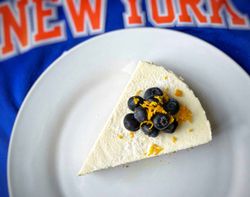While many people believe the dessert originates from New York, cheesecake is, in fact, said to have originated thousands of years ago.
Generally considered sweet dessert with a thick layer of sweetened cheese, atop a bottom layer of either crushed biscuits or sponge cake, the earliest attested mention of the dish dates back to the 5th century BCE, by Greek physician Aegimus, who wrote a book on the art of making cheesecakes. The recipe differs greatly from the modern version of cheesecake that’s so well known and loved however. As a result, a recipe from Forme of Cury, an English cookbook from 1390, has even prompted Brits such as Heston Blumenthal to argue that the modern version of cheesecake is actually an English invention.
The modern cheesecake, as its now best known, was not created until the 18th century. Beaten eggs would be used instead of yeast, while cream cheese was an American addition. Developed in 1872, commercial American cream cheese was accidentally created by a New Yorker while looking for a way to recreate the soft French cheese, Neufchâtel. The result was an “unripened cheese” heavier and creamier than normal: perfect for cheesecake recipes.
Cream cheese has since become a staple ingredient of many cheesecakes, including the world-famous New York cheesecake. Having been popular since the 1900s, available in countless New York restaurants, Arnold Reuben is generally credited with inventing the dish – although better known for his signature sandwiches. The New York cheesecake has an incredibly smooth texture while the richness is brought on by the addition of extra egg yolks and a good dollop of sour cream. For this New York Cheesecake, the dish is slowly baked and then chilled for a few hours (ideally overnight). While most of the preparation time is inactive, the dish does takes a while to be ready, but the results are worth every second.

New York Cheesecake
Equipment
- 9-inch spring form pan
- Stand mixer (optional but recommended)
Ingredients
For the base
- 180 g Digestive biscuits or Graham Crackers if available
- 100 g butter plus extra for greasing
- 2 tbsp brown sugar
- ¼ tsp sea salt
For the filling
- 900 g full fat cream cheese
- 300 g white sugar
- 4 whole eggs
- 2 egg yolks
- 250 ml sour cream
- 1 tbsp vanilla extract
- 2 tsp lemon juice
- 3 tbsp plain flour
- ¼ tsp salt
To garnish (optional)
- Blueberries a handful
- Orange zest
Instructions
- Pre-heat the oven to 180/Gas 4.
- To make the base, add the digestives, brown sugar and a pinch of salt to a food processor and pulse to combine. Alternatively crush the biscuits by hand and mix with the sugar and salt.
- Melt the butter and pour over the crushed biscuit mixture. Pulse or mix to completely combine.
- Grease a spring form cake pan (approx. 9-inches) and add the biscuit base. Tamp it down until even and flat, then par-bake in the oven for 10-15 minutes until it begins to brown. Set aside to cool while you prepare the filling.
- To make the filling, add the cream cheese to the bowl of a stand mixer with a paddle attachment, along with 1/3 of the white sugar and the remaining salt. Mix to combine for around a minute then scrape down the sides of the bowl and add another 1/3 of the sugar. Mix again on medium speed for another 30 seconds or so, then add the rest of the sugar and mix for another 30 seconds.
- Scrape down the sides of the bowl and add the egg yolks. Mix until combined then add the whole eggs, two at a time. Continue to mix for another minute or two until everything is well-combined, continuing to regularly scrape down the sides of the bowl so the filling is smooth.
- Add the sour cream, lemon juice and vanilla extract, and scrape down the sides. Mix for another minute or so on low speed, to avoid overworking.
- At this point, optionally pass the filling through a fine mesh sieve into another bowl to make sure the filling is exceptionally smooth.
- Grease the exposed inner sides of the spring-form pan and pour the mixture over the biscuit base. Use a fork to pop any bubbles that rise to the surface, then bake in the oven at 110C/Gas ¼ for 45 minutes. Pop any bubbles that have risen to the surface then return to the oven for another 2 hours – 2 hours and 45 minutes, dependent on how firm you like your cheesecake.
- Increase the heat to the oven’s highest setting and cook for an additional 5-10 minutes, keeping an eye on it, to slightly brown the top.
- Remove from the oven, use a knife to gently separate the sides of the cheesecake from the pan, then cool and refrigerate for 6-8 hours before serving.
- Slice with a sharp knife and optionally garnish with a handful of blueberries and a smattering of orange zest.

